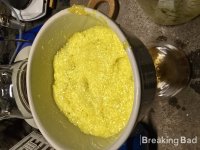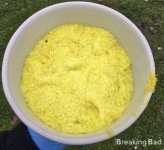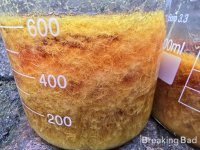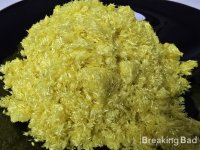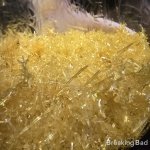- Language
- 🇵🇱
- Joined
- Jun 17, 2024
- Messages
- 8
- Reaction score
- 22
- Points
- 3
- Deals
- 16
First of all I want to thank G. Patton and WillD for their support and chemical knowledge that helped me get very good results of synthesis with great success for the first time. This synthesis can be used for different types of benzaldehydes that are in powder form and instead of nitroethane use Nitromethane. Because this reaction is very universal.
1.) Pour 1000 ml of glacial acetic acid (GAA) into a 5L beaker.
2.) Grind 3,4,5 trimethoxybenzaldehyde in an electric coffee grinder into a powder.
3.) Pour 3,4,5 trimethoxybenzaldehyde in powder form 300 g into a 5L beaker with acetic acid (GAA) – mix the entire contents with a porcelain spatula or glass rod until the powder dissolves.
4.) Pour the entire contents of dissolved 3,4,5 trimethoxybenzaldehyde in acetic acid (GAA) from the 5L beaker into the reaction vessel - a 2L glass flask with a thermometer port.
5.) Pour 100 ml of cyclohexylamine into the reaction vessel - a 2L glass flask - white smoke is formed in the reaction vessel and the reaction mixture begins to heat up - take the glass flask in your hand and stir vigorously.
6.) Pour 400 ml of nitroethane into the reaction vessel - a 2L glass flask - take the glass flask in your hand and stir vigorously.
7.) Put a reflux condenser on the reaction flask - a spiral or ball condenser and fasten it with a clamp for ground joints.
8.) we put the glass flask into the heating socket (instead of the heating socket we can also use a wide 5L beaker into which we put a single-necked flat-bottomed glass flask – then we make a water bath by adding water to the beaker)
9.) we slowly heat the reaction flask to a temperature of 70*C -85*C for a minimum of 3 hours – if we increase the heating time to 6 hours we will increase the yield of the final product.
10.) we remove the reflux condenser from the 2L glass flask and pour the reaction mixture into the 5L beaker. We leave the beaker with the reaction mixture to cool until it reaches room temperature (the first yellow crystals start to appear at the bottom of the beaker). When it reaches room temperature, we put the 5L beaker in the fridge or freezer). The mixture begins to crystallize strongly – it is best to leave the mixture to crystallize for 2 days.
11.) Pour the reaction mixture from the 5 L beaker into the second 5 L beaker. In the first 5 L beaker, beautiful golden crystals of 3,4,5 TRIMETHOXY-P2NP remain. Transfer the 3,4,5 TRIMETHOXY-P2NP crystals from the first 5 L beaker to the Buchner funnel and turn on the vacuum pump. Pour a small amount of cold isopropanol (IPA) over the crystals on the Buchner funnel to clean the 3,4,5 TRIMETHOXY-P2NP crystals.
12.) Transfer the cleaned 3,4,5 TRIMETHOXY-P2NP crystals from the Buchner funnel to a PVC cuvette (another porcelain or glass container) to dry out a bit.
13.) to the second 5L beaker containing the cooled reaction mixture, add distilled water – about 500ml to 1500ml and mix the entire contents with a porcelain or glass rod. This will give you additional 3,4,5 TRIMETHOXY-P2NP crystals with smaller grain size than in the first crystallization.
14.) Filter the reaction mixture from the 5L beaker with additional 3,4,5 TRIMETHOXY-P2NP crystals on a Buchner funnel with the vacuum pump on.
15.) Transfer the mass with contaminated crystals to a 1L or 2L beaker. The volume with crystals should not exceed 60% of the beaker height. Add about 100ml – 150ml of isopropanol (IPA) to the beaker so that the crystals can dissolve. Place the beaker on the hotplate and wait for the isopropanol to boil. (Every now and then stir everything with a glass rod or porcelain spoon). When we reach the boiling point of isopropanol (IPA), the 3,4,5 TRIMETHOXY-P2NP crystals will start to change state to liquid (melting point is about 97*C). When everything becomes liquid, remove the beaker from the hotplate and wait for the temperature to drop to ambient temperature. We can also put the beaker in the freezer.
16.) After 24 hours, we obtain additional large crystals of 3,4,5 TRIMETHOXY-P2NP. Filter everything on a Buchner funnel with the vacuum pump turned on. Wash the crystals on the Buchner funnel with a small amount of cold IPA.
17.) Transfer the crystals from the funnel to another container to dry.
The yield is about 70%
1.) Pour 1000 ml of glacial acetic acid (GAA) into a 5L beaker.
2.) Grind 3,4,5 trimethoxybenzaldehyde in an electric coffee grinder into a powder.
3.) Pour 3,4,5 trimethoxybenzaldehyde in powder form 300 g into a 5L beaker with acetic acid (GAA) – mix the entire contents with a porcelain spatula or glass rod until the powder dissolves.
4.) Pour the entire contents of dissolved 3,4,5 trimethoxybenzaldehyde in acetic acid (GAA) from the 5L beaker into the reaction vessel - a 2L glass flask with a thermometer port.
5.) Pour 100 ml of cyclohexylamine into the reaction vessel - a 2L glass flask - white smoke is formed in the reaction vessel and the reaction mixture begins to heat up - take the glass flask in your hand and stir vigorously.
6.) Pour 400 ml of nitroethane into the reaction vessel - a 2L glass flask - take the glass flask in your hand and stir vigorously.
7.) Put a reflux condenser on the reaction flask - a spiral or ball condenser and fasten it with a clamp for ground joints.
8.) we put the glass flask into the heating socket (instead of the heating socket we can also use a wide 5L beaker into which we put a single-necked flat-bottomed glass flask – then we make a water bath by adding water to the beaker)
9.) we slowly heat the reaction flask to a temperature of 70*C -85*C for a minimum of 3 hours – if we increase the heating time to 6 hours we will increase the yield of the final product.
10.) we remove the reflux condenser from the 2L glass flask and pour the reaction mixture into the 5L beaker. We leave the beaker with the reaction mixture to cool until it reaches room temperature (the first yellow crystals start to appear at the bottom of the beaker). When it reaches room temperature, we put the 5L beaker in the fridge or freezer). The mixture begins to crystallize strongly – it is best to leave the mixture to crystallize for 2 days.
11.) Pour the reaction mixture from the 5 L beaker into the second 5 L beaker. In the first 5 L beaker, beautiful golden crystals of 3,4,5 TRIMETHOXY-P2NP remain. Transfer the 3,4,5 TRIMETHOXY-P2NP crystals from the first 5 L beaker to the Buchner funnel and turn on the vacuum pump. Pour a small amount of cold isopropanol (IPA) over the crystals on the Buchner funnel to clean the 3,4,5 TRIMETHOXY-P2NP crystals.
12.) Transfer the cleaned 3,4,5 TRIMETHOXY-P2NP crystals from the Buchner funnel to a PVC cuvette (another porcelain or glass container) to dry out a bit.
13.) to the second 5L beaker containing the cooled reaction mixture, add distilled water – about 500ml to 1500ml and mix the entire contents with a porcelain or glass rod. This will give you additional 3,4,5 TRIMETHOXY-P2NP crystals with smaller grain size than in the first crystallization.
14.) Filter the reaction mixture from the 5L beaker with additional 3,4,5 TRIMETHOXY-P2NP crystals on a Buchner funnel with the vacuum pump on.
15.) Transfer the mass with contaminated crystals to a 1L or 2L beaker. The volume with crystals should not exceed 60% of the beaker height. Add about 100ml – 150ml of isopropanol (IPA) to the beaker so that the crystals can dissolve. Place the beaker on the hotplate and wait for the isopropanol to boil. (Every now and then stir everything with a glass rod or porcelain spoon). When we reach the boiling point of isopropanol (IPA), the 3,4,5 TRIMETHOXY-P2NP crystals will start to change state to liquid (melting point is about 97*C). When everything becomes liquid, remove the beaker from the hotplate and wait for the temperature to drop to ambient temperature. We can also put the beaker in the freezer.
16.) After 24 hours, we obtain additional large crystals of 3,4,5 TRIMETHOXY-P2NP. Filter everything on a Buchner funnel with the vacuum pump turned on. Wash the crystals on the Buchner funnel with a small amount of cold IPA.
17.) Transfer the crystals from the funnel to another container to dry.
The yield is about 70%

